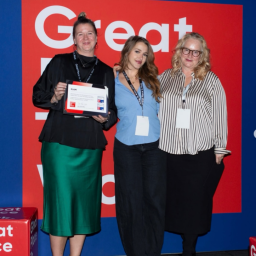HR Ressources Recent Blogs
May 12, 2021
Did you know that an academic framework is a useful tool for conceptualizing learning strategies for businesses?
Over the past decade, the global workforce has been constantly evolving. The current business environment is fast-paced and demanding. Global management employees need the skills to face ever-changing situations, so their development in the corporate world cannot be left to chance. A good learning and development strategy incorporates employee executive training, so their work skills are always sharpened. The shift to a digital, knowledge-based economy means that a vibrant workforce is more important than ever: research suggests that a very significant percentage of market capitalization in public companies is based on intangible assets—skilled employees, exceptional leaders, and knowledge. These assets can be greatly solidified by learning and development classes.
![schema]() To get the most out of investments in training and language learning programs such as at ELAM and curriculum development, employees must embrace a broader role within the organization and formulate an ambitious vision for the function of learning. An essential component of this effort is a comprehensive, coordinated strategy that engages the organization and encourages collaboration. The ACADEMIES©framework, which consists of nine dimensions of L&D, can help to strengthen the function and position it to serve the organization more effectively. Learning, after all, is an important part of company culture and business growth. So why is it so difficult for businesses to understand that learning is also a strategic asset for the corporation? What HR and learning leaders can do to push business counterparts to get behind learning and training programs, and to invest in learning innovation?
1. Build strategic learning assets by forming partnerships and collaborating.
Your employees invest significant time in their work. And before the pandemic, most likely they also were spending 40+ hours a week (physically speaking) at the workplace. Building relationships with your colleagues makes sense not just for practical and professional reasons, but also for mental health reasons, particularly if you spend so much time at work. According to Gallup’s “State of the American Workplace” report, “forming friendships with your co-workers increases your levels of happiness and makes you a more engaged employee.” You’ll be able to clarify all of the advantages of a strategic learning program and discuss possibilities based on their perspectives if you have these relationships. As a result, you can be confident that you will be aligned with the right partners as you embark on your learning transformation path.
To get the most out of investments in training and language learning programs such as at ELAM and curriculum development, employees must embrace a broader role within the organization and formulate an ambitious vision for the function of learning. An essential component of this effort is a comprehensive, coordinated strategy that engages the organization and encourages collaboration. The ACADEMIES©framework, which consists of nine dimensions of L&D, can help to strengthen the function and position it to serve the organization more effectively. Learning, after all, is an important part of company culture and business growth. So why is it so difficult for businesses to understand that learning is also a strategic asset for the corporation? What HR and learning leaders can do to push business counterparts to get behind learning and training programs, and to invest in learning innovation?
1. Build strategic learning assets by forming partnerships and collaborating.
Your employees invest significant time in their work. And before the pandemic, most likely they also were spending 40+ hours a week (physically speaking) at the workplace. Building relationships with your colleagues makes sense not just for practical and professional reasons, but also for mental health reasons, particularly if you spend so much time at work. According to Gallup’s “State of the American Workplace” report, “forming friendships with your co-workers increases your levels of happiness and makes you a more engaged employee.” You’ll be able to clarify all of the advantages of a strategic learning program and discuss possibilities based on their perspectives if you have these relationships. As a result, you can be confident that you will be aligned with the right partners as you embark on your learning transformation path.
![cubes]() 2. Speak the target language of your audience
Each business unit has a common “language” that they use to complete tasks. Finance, for example, may not be as enthusiastic about consumers as someone in Customer Success. As a learning leader, it is your responsibility to learn each organization’s lingo so that you can not only understand their objectives but also how to communicate with them. If you want to assimilate into the executive community, you will need to know how to speak the language of business executives. The two key concepts you will need to know are dollars and details.
You should begin with the following:
2. Speak the target language of your audience
Each business unit has a common “language” that they use to complete tasks. Finance, for example, may not be as enthusiastic about consumers as someone in Customer Success. As a learning leader, it is your responsibility to learn each organization’s lingo so that you can not only understand their objectives but also how to communicate with them. If you want to assimilate into the executive community, you will need to know how to speak the language of business executives. The two key concepts you will need to know are dollars and details.
You should begin with the following:
 To get the most out of investments in training and language learning programs such as at ELAM and curriculum development, employees must embrace a broader role within the organization and formulate an ambitious vision for the function of learning. An essential component of this effort is a comprehensive, coordinated strategy that engages the organization and encourages collaboration. The ACADEMIES©framework, which consists of nine dimensions of L&D, can help to strengthen the function and position it to serve the organization more effectively. Learning, after all, is an important part of company culture and business growth. So why is it so difficult for businesses to understand that learning is also a strategic asset for the corporation? What HR and learning leaders can do to push business counterparts to get behind learning and training programs, and to invest in learning innovation?
1. Build strategic learning assets by forming partnerships and collaborating.
Your employees invest significant time in their work. And before the pandemic, most likely they also were spending 40+ hours a week (physically speaking) at the workplace. Building relationships with your colleagues makes sense not just for practical and professional reasons, but also for mental health reasons, particularly if you spend so much time at work. According to Gallup’s “State of the American Workplace” report, “forming friendships with your co-workers increases your levels of happiness and makes you a more engaged employee.” You’ll be able to clarify all of the advantages of a strategic learning program and discuss possibilities based on their perspectives if you have these relationships. As a result, you can be confident that you will be aligned with the right partners as you embark on your learning transformation path.
To get the most out of investments in training and language learning programs such as at ELAM and curriculum development, employees must embrace a broader role within the organization and formulate an ambitious vision for the function of learning. An essential component of this effort is a comprehensive, coordinated strategy that engages the organization and encourages collaboration. The ACADEMIES©framework, which consists of nine dimensions of L&D, can help to strengthen the function and position it to serve the organization more effectively. Learning, after all, is an important part of company culture and business growth. So why is it so difficult for businesses to understand that learning is also a strategic asset for the corporation? What HR and learning leaders can do to push business counterparts to get behind learning and training programs, and to invest in learning innovation?
1. Build strategic learning assets by forming partnerships and collaborating.
Your employees invest significant time in their work. And before the pandemic, most likely they also were spending 40+ hours a week (physically speaking) at the workplace. Building relationships with your colleagues makes sense not just for practical and professional reasons, but also for mental health reasons, particularly if you spend so much time at work. According to Gallup’s “State of the American Workplace” report, “forming friendships with your co-workers increases your levels of happiness and makes you a more engaged employee.” You’ll be able to clarify all of the advantages of a strategic learning program and discuss possibilities based on their perspectives if you have these relationships. As a result, you can be confident that you will be aligned with the right partners as you embark on your learning transformation path.
 2. Speak the target language of your audience
Each business unit has a common “language” that they use to complete tasks. Finance, for example, may not be as enthusiastic about consumers as someone in Customer Success. As a learning leader, it is your responsibility to learn each organization’s lingo so that you can not only understand their objectives but also how to communicate with them. If you want to assimilate into the executive community, you will need to know how to speak the language of business executives. The two key concepts you will need to know are dollars and details.
You should begin with the following:
2. Speak the target language of your audience
Each business unit has a common “language” that they use to complete tasks. Finance, for example, may not be as enthusiastic about consumers as someone in Customer Success. As a learning leader, it is your responsibility to learn each organization’s lingo so that you can not only understand their objectives but also how to communicate with them. If you want to assimilate into the executive community, you will need to know how to speak the language of business executives. The two key concepts you will need to know are dollars and details.
You should begin with the following:
- Cost reducing
- Time to proficiency
- Increase productivity















